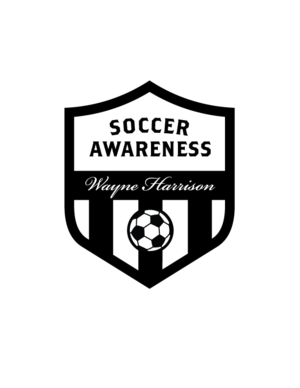Developing “Movement Off The Ball” Through The Directional Passing And Support Three Zone Game - Training Center Exclusive
/Running With And Without The Ball
Long Passing (Playing area is 60 by 40)
You can use various numbers of players at each end of the grid in this sequence.
Pass and move in own grid until eye contact with a player in the other grid (or a call) then play a long pass to that player. Balls are constantly changing grids; players have to have awareness in their own grid to receive but also awareness of when a pass is on from the other grid (must have head up and be constantly looking around to see this). If they don’t observe where their own teammates are or those in the other grid are, they won’t be successful with this so they must play with their head up and have the ability to look away from the ball as well as at it, observing all the options that are on both in their own grid and the other one.
Conditions – Ball can’t bounce between grids for chipped or lofted passes, or must be driven along the ground with pace for quick passing.
Develop Running with the Ball across the grids. Pass and move within own grid then a player picks a moment to run and takes it.
Keep balance of balls in each grid. Can start with one in each; try to avoid two in one grid at once. Increase to two balls per grid.
Long pass then follow the ball (supporting the pass) into the other grid so not only balls being transferred but also players. Players must move as quickly as possible to support in the other grid.
Coaching Points:
Awareness of the positions of players in both grids thus ensuring the players have their heads up to see the pass when it is on to do it.
Movement off the ball to make themselves available in both grids to receive a pass.
Quality of short passing in one grid and long passing into the other grid.
Depending on the theme, the development of awareness of when and where to pass, to run with the ball, to make a movement off the ball (third man run for example), to receive and turn with the ball, and so on.
Running With The Ball
The skill practiced here is specifically running with the ball, still identifying passing and moving options but also looking to make a run when the time is right.
Coaching Points for Running with the ball
Head Up – look forward
Good first touch out of feet, 3-4 touches maximum, not dribbling.
Run in a straight line, the quickest route.
Running Style, use the front foot to control the ball using the lace
Passing Then Supporting The Pass
This is like a player passing into a striker and receiving the pass back (one touch if possible for quickness of transition) and then running the ball forward into the attacking third
Third Man Run Development
A player makes a run into the neutral area between the grids; a player on the ball must see this quickly and pass to the player making the run. Try to drop the ball in front of them to run onto. Running player then takes ball into other grid and at the same time this is happening another player goes the opposite way. Start with one ball in each grid and build up.
Progression – the type of runs to be made, straight or diagonal runs. Diagonal passes and straight runs, and diagonal runs and straight passes as above or diagonal runs and diagonal passes. Equate the situation with how to make it difficult for defenders in a game to mark players who make different types of runs. Here above, (F) Passes to (E) but continues the run forward, (E) passes back to (D) who passes into the path of (F) continuing the forward run.
If a player makes a run and doesn’t receive a pass then they work their way back into their own grid. Relate the move to a player making a forward run, they don’t get the pass, they work back, draw a defender with them and then another player makes the run into the space left to receive a through ball.
Receiving and Turning – a player moves out the area and positions side on at an angle to receive and turn (looking before receiving) and take the ball to the other grid. Same happens on the other side.
Coaching Points:
Timing of the 3rd man run off the ball into space
Observation of the run by the player on the ball
Pace, accuracy and timing of the pass in front of the receiving player
Playing Give And Go’s
A player moves into the neutral zone (with a third man run off the ball) and another player on the ball passes to them. The passer then follows and receives a pass back (a 1– 2 move) and then passes the ball into the other grid, both players move into the other grid and join in. On entering, the existing players in this grid must balance things up and look to break in twos the other way as soon as possible.
Progression: Introduce a defender in each grid. This is now a 4 v 1 and only one ball per grid.
As the number of players involved increases so increase the number of balls used so at times two players can be making moves across the free space from the same grid at the same time, hence there is constant movement between grids. The players will get good at passing and moving and being able to look beyond the ball and at the same time making quick decisions the more they practice this session.
Introducing Defenders
Up to now there have been mainly NO OPPOSITION GAMES, SHADOW PLAYS to allow players to develop anticipation, awareness, vision and imagination regarding passing, receiving, support and composure on the ball to name just a few of the many aspects of play this helps develop, we can now introduce DEFENDERS to add pressurizing situations to test the players.
Introduce defenders to put the players under pressure when they pass or run the ball across the middle of the field. It can begin with 2 defenders, then 3 defenders to make it more difficult where defenders can intercept passes or tackle players with the ball.
Use this at every stage of the work out as the players get good at it. This would include:
passing across the area,
running the ball across the area,
third man runs,
passing then support the pass,
playing give and go’s,
receiving and turning, and so on.
This is taking the session to a more competitive level with defenders included now. Now the players not only have to focus on passing, running and supporting in their own zone, and into the other zone, they have to see where the defenders are to get past them.
If a defender intercepts the ball they switch quickly with the player whose pass was intercepted.
Have a 5 v 1 in each zone introducing defenders to make the situation competitive. To begin we can have one ball only then introduce a ball each side.
Players need to get a certain number of passes in before it goes to the other side. It may be that at any one time there will be two balls in one side so this team must get a ball to the other side to balance it as soon as possible.
Can introduce running with the ball across the free zone into the other area, third man running and receiving, passing first then third man running, passing into the other zone then joining in following the pass and so on.
All this results in a more competitive environment to work in for the players with them being put under pressure to test their awareness more thoroughly.
Always attempting to keep the balance in both sides with a ball each.
If a defender wins the ball then the player who gave it away becomes the defender. Have defenders just hold a bib to identify them as defenders so the transitions are quick and effective.
Competitive: Add keepers and have a game.


















